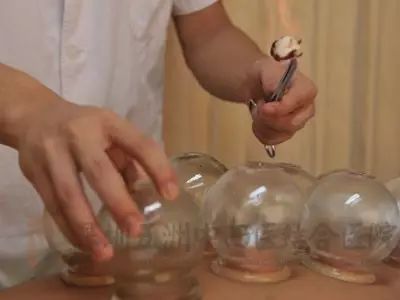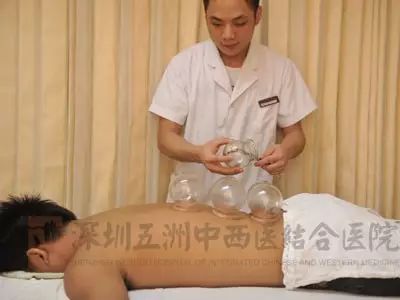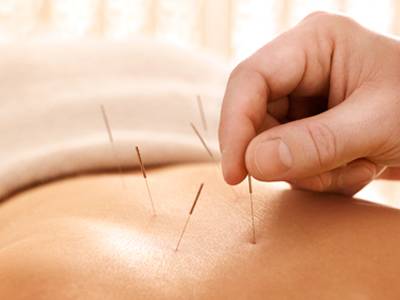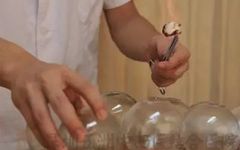Also known as single cup use, this method is generally used to treat diseases with localized lesions. The appropriate size of the cupping jar can be selected based on the size of the lesion or the area of tenderness. For soft tissue sprains and strains, the Ah Shi point (阿是穴) can be selected; for “tennis elbow,” the lateral epicondyle of the humerus is chosen; and for abscesses, cupping can be applied after incision or spontaneous rupture to drain pus.
The multiple cupping method involves using several cups simultaneously, generally for treating diseases with a broader range of lesions and fuller muscle areas. If there are many sensitive reaction points, several to over ten cups can be applied based on the anatomical characteristics of the lesion site. For example, when treating a muscle strain, multiple cups can be arranged along the direction of the muscle, known as the排罐法 (排罐法). The spacing can be close or far apart; close spacing (less than 3.5 cm) is called密排法 (密排法), while far spacing (greater than 7 cm) is called疏排罐法 (疏排罐法).
The retained cupping method, also known as sitting cupping, refers to the technique of leaving the cup in place for a period after suctioning. The retention time is generally 5 to 20 minutes; for larger cups with strong suction, the retention time should be appropriately reduced. In summer or on thin skin, the retention time should not be too long. If blood stasis is to be treated, the time can be slightly extended, but care should be taken not to break the skin or cause blisters. This method can be used for most conditions treated with cupping and is the most commonly used cupping technique.

The flash cupping method involves immediately removing the cup after suctioning at the treatment site. This method is repeated until the skin becomes reddened; if done continuously for about 20 times, it is also known as continuous flash cupping. This method has a more pronounced stimulating effect and is suitable for weak conditions such as muscle atrophy, local skin numbness, or functional decline, as well as sequelae of stroke. Since flash cupping is a method of congestive cupping, it does not leave bruises on the skin, making it more suitable for facial cupping.
The sliding cupping method, also known as push cupping or rotating cupping, involves applying a thin layer of lubricant, such as paraffin or petroleum jelly, to the rim of the cup or the suction area before operation. After suctioning, the operator holds the front of the cup with the left hand and pushes or tilts the bottom of the cup with the right hand, moving it in forward, backward, left, and right directions. Circular movements can also be made as needed. The skin in the area of the sliding cup may show redness, deep red, or raised spots, indicating the end of treatment. This method is best performed with larger, thicker-walled, and smooth glass or acrylic cups. It is commonly used on larger areas with thicker muscles, such as the chest, back, lower back, abdomen, and thighs, and is often used to treat paralysis, muscle atrophy, neuralgia, and rheumatic pain.
The warm cupping method involves using infrared devices, heat lamps, or moxibustion around the cupping area during treatment. This not only enhances the therapeutic effect but also prevents the patient from getting cold. This method combines the effects of cupping and heat therapy and is generally used in cold and damp seasons or for patients with conditions of deficiency-cold or cold-damp diseases.

The finger cupping method involves first using the fingers to press on the acupoints (点穴) or massage the affected area before performing cupping. This method combines the effects of cupping, acupuncture, and massage, enhancing the therapeutic effect and expanding the treatment range. It is commonly used for acute conditions with severe pain, showing significant effects on soft tissue contusions and strains.
The blood cupping method, also known as prick and cupping, involves first using a three-edged needle, plum blossom needle (skin needle), injection needle, or sewing needle to prick the acupoints or treatment area according to the size of the lesion and the required amount of bleeding (light pricking to produce redness, moderate pricking to cause slight bleeding, and heavy pricking to cause pinpoint bleeding), followed by cupping and retention. The duration of retention depends on the required amount of bleeding for different areas and conditions, generally ranging from a few drops to several milliliters. This method is suitable for various acute and chronic soft tissue injuries, high fever, neuralgia, neurodermatitis, and erysipelas.
The needle cupping method involves needling an acupoint to achieve “deqi” (得气) and leaving the needle in place, then cupping around the needle. It is also known as retained needle cupping or needle-in-cup cupping. Alternatively, after needling an acupoint to achieve “deqi,” the needle can be removed without pressing the needle hole, and cupping can be performed immediately at the site of needle removal, extracting a small amount of blood or tissue fluid. This method combines the effects of cupping and acupuncture, enhancing therapeutic efficacy and is often used for stubborn pain syndromes where cupping alone is ineffective, as well as for various chronic soft tissue injuries.
The warm needle cupping method builds on the needle cupping method by adding infrared devices, heat lamps, or moxibustion to the local area and around the cup. This method combines the effects of acupuncture, cupping, and heat therapy, making it suitable for treating various chronic and stubborn deficiency-cold diseases, with good therapeutic results.

Source: Internet

Address: Department of Orthopedics and Massage, Water Park Hospital, Nankai District, Tianjin (No. 11 Xinyuan Road, opposite the back door of Xinyuan Apartment)
Phone: 15710297524 or 15710297924 or 15710297545
Nearby bus stops: Wangdingdi Interchange Bridge, Jiatai Garden, Shanxi Hotel, Tianjin Library

